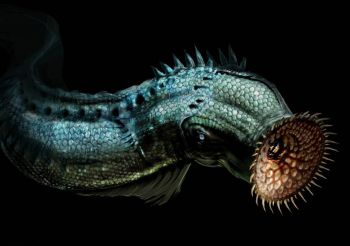Difference between revisions of "Lamprey"
Tao alexis (talk | contribs) |
Tao alexis (talk | contribs) |
||
| Line 39: | Line 39: | ||
[[File:Lamprey.jpg|left|350px]] | [[File:Lamprey.jpg|left|350px]] | ||
| − | The '''common lamprey''' migrates from saltwater to freshwater in order to breed, | + | The '''common lamprey''' migrates from saltwater to freshwater in order to breed; these are the most dangerous, as they may be found in any large freshwater body of water. The '''giant lamprey''' breeds in intertidal pools but are less likely to be encountered because locals tend to be aware of their habitats. At those times of the year when giant lampreys gestate between 40 and 100 eggs, these pools can become extremely dangerous, until such time as the rising tide dissipates the "swarm." |
Any hit by a lamprey that causes 2 points of [[Damage (hit points)|damage]] indicates the creature has successfully attached itself. Thereafter, until it is killed or made helpless, the '''blood drain''' that follows will enable to the lamprey to automatically cause damage, according to its size. A common lamprey would drain 1-2 [[Hit Points|hit points]] per [[Combat Round|round]], while the giant lamprey would cause 1-6. | Any hit by a lamprey that causes 2 points of [[Damage (hit points)|damage]] indicates the creature has successfully attached itself. Thereafter, until it is killed or made helpless, the '''blood drain''' that follows will enable to the lamprey to automatically cause damage, according to its size. A common lamprey would drain 1-2 [[Hit Points|hit points]] per [[Combat Round|round]], while the giant lamprey would cause 1-6. | ||
Revision as of 19:10, 30 September 2021
| Type | Lamprey (common) | Giant Lamprey |
| Species | jawless fish | |
| No. Appearing | 5-20 | 1-4 |
| Behaviour | solitary | |
| Range | intertidal, wetland | coral reef, intertidal |
| Size | 25 in. long | 6 ft. 2 in. long |
| Weight | 9 lbs. | 240 lbs. |
| Intelligence | 0 | 0 |
| Armour Class | 9 | 8 |
| Hit Dice | 1 | 3 |
| Action Points | 2 | 3 |
| Max. Stride | 2 | 2 |
| THAC0 | 20 | 19 |
| Hp/Die | d2 | d8 |
| Attack Form | bite | |
| Damage | 1-2 | 1-6 |
| Special Attack | blood drain | |
Lampreys are ancient creatures whose bodies are characterized by a toothed, funnel-like sucking mouth. They inhabit both fresh and salt water bodies of water, preying upon other fish for food. When attacking, they attach themselves and suck their blood. There is danger for land mammals and humanoids who enter waters inhabited by these creatures, who will attack anything for food.
The common lamprey migrates from saltwater to freshwater in order to breed; these are the most dangerous, as they may be found in any large freshwater body of water. The giant lamprey breeds in intertidal pools but are less likely to be encountered because locals tend to be aware of their habitats. At those times of the year when giant lampreys gestate between 40 and 100 eggs, these pools can become extremely dangerous, until such time as the rising tide dissipates the "swarm."
Any hit by a lamprey that causes 2 points of damage indicates the creature has successfully attached itself. Thereafter, until it is killed or made helpless, the blood drain that follows will enable to the lamprey to automatically cause damage, according to its size. A common lamprey would drain 1-2 hit points per round, while the giant lamprey would cause 1-6.
See Bestiary
